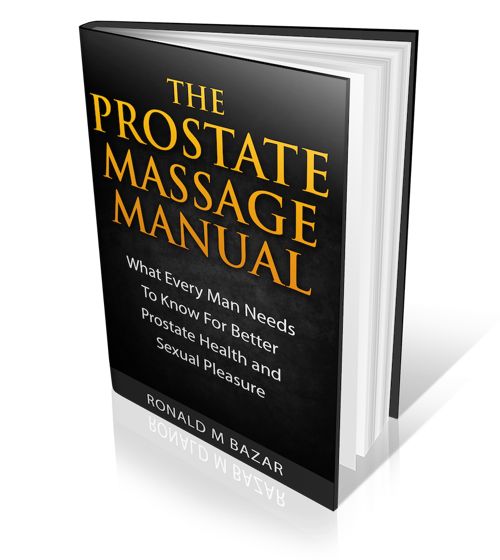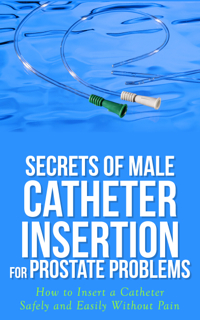
Types of Catheters for
Male Catheter Insertion
You'll need to know the types of catheters in the event that all else fails when you are having a prostate attack, and you either can't or don't want to go to emergency.
If you do have prostate symptoms and/or are prone to prostate attacks, you should always have a male catheter kit on hand when travelling or at home for emergencies. It is far less stressful to do it yourself than going to emergency rooms and waiting and waiting. It is much easier and less painful than you may imagine.
Obviously, if you do not have a catheter and no urine is coming out, then seeing a doctor or going to the emergency room is the solution. Know that there is no danger of bladder eruption for quite a long period, even up to 2 days. The pain may be extreme, but you have time to get help.
Be aware that something triggered the attack. If you can figure it out — now or in the morning — then you will have good information about what not to do again, and you can avoid repeating the experience.
I was buying catheters at a pharmacy a few years ago, and the pharmacist said he sells many types of catheters these days. This was unheard of before. (My Dad was a pharmacist, and I worked alongside him for years. We didn't even have catheters then, only condoms hidden away in a drawer and only to be sold discretely!) Today many, many men are dealing with an enlarged inflamed prostate.
The first thing I want to share with you is that using a catheter sounds way worse than it actually is. If you have heard horror stories then know that it does not have to be like that for you.
If you get the right size (thickness of tube), the right type, and you know how to use it, then the pain is minimal. In fact, it is more a discomfort than a pain. What is painful is the fact that you can’t pee and—because of it—you are in distress. In a matter of minutes you can find relief and, oh what a feeling that is! Believe me!
There are several very specialized types of catheters but, for our purposes, there are two versions of catheters for men: internal and external catheters.
- Internal catheter = Stopped. Can’t Go.
- External catheter = Going. Can’t Stop.
The internal catheters are used to help you pee when your prostate blocks your pee tube. The external catheters are for situations in which you do not want to have to run (or can’t run) to the washroom to pee (e.g., traveling or at a ball game), or if you have a sudden urgency that you can’t control.
It is like a condom with a tube at the end that goes to a small bag on your leg. You go when you have to and can empty the bag later. A condom catheter is a very convenient device with no pain and peace of mind.
Here we focus on the internal catheters because those are the ones we need to use to pee when we’re blocked. There are basically two types of internal catheters:
- single use catheters (also known as short-term or intermittent catheters) are removed after you have emptied your bladder, and
- long-term catheters (known as
indwelling Foley catheters or just Foley catheters), which have an inflatable balloon
function at the end to allow the catheter to stay inside without slipping out. These are used after surgery or for extreme conditions such as acute urinary retention.
If you have a sudden prostate block and can't pee, what you want is a simple, single-use, male catheter. You can buy them at your pharmacy, medical supply store, or online (see the sources listed below).
But first let me explain more about these single-use, internal male catheters.
For your emergency use, you want to get 12-gauge catheters. These are quite thin. Fourteen-gauge is acceptable, even 16, if that is all you can find. Boys use 10s. They come all the way to 28 gauge (ouch!).
Now there are two types of catheters for single-use: very flexible and a bit stiffer. They each have an advantage. The flexible ones are very soft and pliable, which is nice but may be a bit harder to insert all the way through. The stiffer versions allow an easier transit during the last stage through the prostate and into the bladder. I have used both types of catheters, and I recommend having both available. They are very inexpensive.
Now here is a good tip. Buy some Xylocaine or Lidocaine ointment in a tube. Some Xylocaine brands come with a special cone applicator cap that you insert the tip into the opening of your penis and squeeze some in (you can do this with just the tip of the tube if it comes with no special applicator). It lubricates the catheter and acts as a desensitizer so you barely feel the catheter going in.
Lubricated catheters are relatively new. These are the Rolls Royce of catheters because the lubrication makes them easy to insert! The whole catheter is lubricated. They just glide right in!
Yup, these are the catheters to
use! They do not need any Xylocaine unless you feel extra lubrication
is needed. I was so pleased when I used these types of catheter the last few times I
needed one. I wish I had had them before! They are worth the
extra price. They are called SpeediCaths.
Tip Tips!
There are two types of catheter tips:
- straight-tipped catheters or
- Coudé (French for elbowed) catheters. The Coudé ones have a slight bend at the tip to allow easier passage through an enlarged prostate. This angled part is only about 1/6” long.
I like the Coude catheter because it helps get through the last bit of the prostate, especially if it is enlarged. But straight tipped ones are fine, too. It is just a matter of preference. But both or either will work just fine.
Touchless catheters: The best of them all!
Touchless catheters for men are a form of penile catheter perfect for self catheterization. Unlike a permanent catheter, these are disposable intermittent hydrophilic catheters.
That means they are lubricated and can be inserted by just holding the opposite end from that which is inserted. That's why they are called "touchless" — you don't have to touch the tube itself.
In addition, these catheters have a thin hydrophilic
surface coating. When immersed in the saline solution in the package, this coating swells to a
smooth, slippery film making the catheter far easier, safer and more comfortable to
insert.
They come pre-hydrated. They can be used right out of the package. They are known as SpeediCaths. Individually packed and sterile, these are the best of the best.
They are fast to use, basically require nothing else other than something to wash the tip of your penis — soap and water, or an alcohol or iodine wipe.
And they are fast to insert. That's why they are known as Speedicath.
SpeediCath Coudé Intermittent Catheters
You can then choose 12 FR, 14" length (that means 12 gauge size).
You can buy one at a time or a box for the best deal.
Catheter Prostate Kit
Here is a list of items to create the minimal Prostate Kit. You really won’t need the optional items, but I list them in case you can’t find the coude catheter: SpeediCaths. If you want other less expensive catheters, go here: Other Catheters
Minimum Prostate Kit:
- 1 SpeediCath catheter lubricated: SpeediCath Coudé Intermittent Catheters or Straight-Tip SpeediCath. Choose 12 gauge 14” (#28492 - 12 FR, 14" Length) catheter for men. Buy several so that you have back-ups for the car, home, work, travel bag, etc. 12 gauge is the thickness of the tube. If you can't get 12s then 14s are ok as well but not quite as thin. 10s are too thin.
- 6– 10 Alcohol Prep Pads. You can get 200 for a few bucks.
- Xylocaine (very optional): Xylocaine Ointment Tube or Lidocaine With SpeediCath, you really do not need these, but if you are worried, then get some.
- KY jelly (also very optional)
- A plastic ziplock bag to hold all the items together as your emergency prostate kit.
For home use:
- The same kit as described above, but you can substitute a bottle of alcohol with Kleenex tissues that you wet for sterilizing in place of the Alcohol Prep Pads.
- Include 2 towels.
Tip: Add a SpeediCath Coudé Intermittent Touchless Catheter to your first aid kit.
IMPORTANT
If you are having troubles inserting then it may be best to go to your emergency at your hospital!
In case you can't here is what to try.
In the very rare case that a lubricated catheter is unable to pass through the prostate using all the above techniques, Use a higher gauge one: if a 12 did not work, then use a 14. If 14 did not work, use a 16.
This is contrary to what you think that a thinner one would be easier to succeed. The problem is that it is not strong enough to push through your enlarged prostate. A wider one will do the trick!
Or if you have tried a 14 or 16 gauge and they haven't worked then dropping down to a 12 or 10 may be successful.
Make sure the blue line is pointing upwards so the coude tip is up and you will be able to push a little firmer. Use some Xylocaine before inserting as described earlier.
First Choice:
SpeediCath Coudé Intermittent Touchless CatheterSpeediCath Coudé Intermittent Touchless Catheter
---------------------
Others:
That's still a soft catheter.
Another option is a stiffer one:
But the size is the key when you have problems getting through. That is why it is wise to have a bigger size as a Plan B just in case.
Go from Types of Catheters to Male Catheter Insertion
Got a Question or Comment about your Prostate Health?
This is the place to post them because I get them immediately.
I like to share them and the answers I provide so others can benefit too.
Your email is kept completely confidential. If you want to be notified when the question is answered, please make sure to add your email address. I don't collect or store these emails after they are used to send you your answer, and they are not posted with your question.
What Other Visitors Have Asked or Said
Click below to see contributions from other visitors to this page...
Great website
Thank you the great website, you helped me understand self catheterization and products available for men.
------
Ron here...
Thanks so much for …
I was miserable with bladder that would not empty: enlarged prostate
I have been to a urologist that was very sarcastic about my bladder issue and only offered flomax and another drug,
I explained to him one day I went …
Iodine vs. Alcohol for Catheters
Cannot help but noticed the incorrect information you have posted on your website:
First, alcohol should never be used as a disinfectant for catheter …
What if you don't feel pain?!!
I am very thankful for all the information and the knowledge you are sharing! I read your book The prostate Health diet and followed it.
I got better …
Sleep Secrets by the author of this website.

Healthy Prostate:
The Extensive Guide To Prevent and Heal Prostate Problems Including Prostate Cancer, BPH Enlarged Prostate and Prostatitis
Get all the info on this site plus much much more:
• extensive guide
• searchable content
• live clickable links
• organized flow of content
• product suggestions and how to lists
• reference links
• AND GET VERY IMPORTANT INFO NOT ON THIS SITE...







